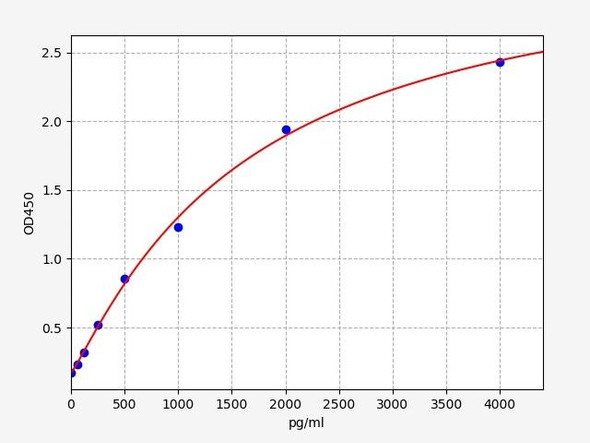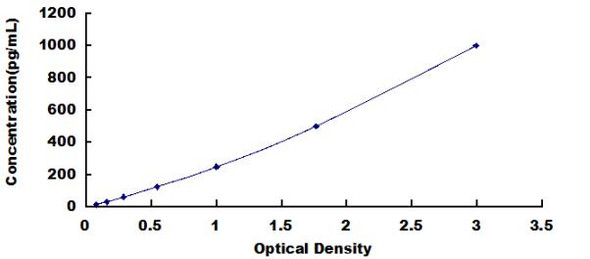Human Cell Biology ELISA Kits 5
Human HGF (Hepatocyte Growth Factor) ELISA Kit (HUES01370)
- SKU:
- HUES01370
- Product Type:
- ELISA Kit
- Size:
- 96 Assays
- Uniprot:
- P14210
- Sensitivity:
- 75pg/mL
- Range:
- 125-8000pg/mL
- ELISA Type:
- Sandwich
- Synonyms:
- F-TCF, HGFB, HPTA, SF, Scatter Factor, Hepapoietin A
- Reactivity:
- Human
- Sample Type:
- Serum, plasma and other biological fluids
- Research Area:
- Cell Biology
Description
| Assay type: | Sandwich |
| Format: | 96T |
| Assay time: | 4.5h |
| Reactivity: | Human |
| Detection Method: | Colormetric |
| Detection Range: | 125.00-8000 pg/mL |
| Sensitivity: | 75.00 pg/mL |
| Sample Volume Required Per Well: | 100µL |
| Sample Type: | Serum, plasma and other biological fluids |
| Specificity: | This kit recognizes Human HGF in samples. No significant cross-reactivity or interference between Human HGF and analogues was observed. |
This ELISA kit uses Sandwich-ELISA as the method. The micro ELISA plate provided in this kit has been pre-coated with an antibody specific to Human HGF. Standards or samples are added to the appropriate micro ELISA plate wells and combined with the specific antibody. Then a biotinylated detection antibody specific for Human HGF and Avidin-Horseradish Peroxidase (HRP) conjugate are added to each micro plate well successively and incubated. Free components are washed away. The substrate solution is added to each well. Only those wells that contain Human HGF, biotinylated detection antibody and Avidin-HRP conjugate will appear blue in color. The enzyme-substrate reaction is terminated by adding Stop Solution and the color turns yellow. The optical density (OD) is measured spectrophotometrically at a wavelength of 450 nm ± 2 nm. The OD value is proportional to the concentration of Human HGF. The concentration of Human HGF in samples can be calculated by comparing the OD of the samples to the standard curve.
| UniProt Protein Function: | HGF: HGF is a potent mitogen for mature parenchymal hepatocyte cells, seems to be an hepatotrophic factor, and acts as growth factor for a broad spectrum of tissues and cell types. It has no detectable protease activity. Activating ligand for the receptor tyrosine kinase MET by binding and promoting its dimerization. Defects in HGF are the cause of deafness autosomal recessive type 39 (DFNB39). A form of profound prelingual sensorineural hearing loss. Sensorineural deafness results from damage to the neural receptors of the inner ear, the nerve pathways to the brain, or the area of the brain that receives sound information. Belongs to the peptidase S1 family. Plasminogen subfamily. 6 isoforms of the human protein are produced by alternative splicing. |
| UniProt Protein Details: | Protein type:Motility/polarity/chemotaxis; Hormone; Cell development/differentiation Chromosomal Location of Human Ortholog: 7q21. 1 Cellular Component: extracellular space; membrane; extracellular region Molecular Function:identical protein binding; protein binding; growth factor activity; protein heterodimerization activity; serine-type endopeptidase activity; chemoattractant activity Biological Process: positive regulation of myelination; mitosis; platelet activation; organ regeneration; activation of MAPK activity; myoblast proliferation; hepatocyte growth factor receptor signaling pathway; negative regulation of caspase activity; proteolysis; liver development; positive regulation of phosphoinositide 3-kinase cascade; positive regulation of osteoblast differentiation; positive regulation of peptidyl-tyrosine phosphorylation; positive regulation of angiogenesis; platelet degranulation; positive chemotaxis; epithelial to mesenchymal transition; positive regulation of transcription from RNA polymerase II promoter; blood coagulation; hyaluronan metabolic process; positive regulation of cell migration Disease: Deafness, Autosomal Recessive 39 |
| NCBI Summary: | Hepatocyte growth factor regulates cell growth, cell motility, and morphogenesis by activating a tyrosine kinase signaling cascade after binding to the proto-oncogenic c-Met receptor. Hepatocyte growth factor is secreted by mesenchymal cells and acts as a multi-functional cytokine on cells of mainly epithelial origin. Its ability to stimulate mitogenesis, cell motility, and matrix invasion gives it a central role in angiogenesis, tumorogenesis, and tissue regeneration. It is secreted as a single inactive polypeptide and is cleaved by serine proteases into a 69-kDa alpha-chain and 34-kDa beta-chain. A disulfide bond between the alpha and beta chains produces the active, heterodimeric molecule. The protein belongs to the plasminogen subfamily of S1 peptidases but has no detectable protease activity. Alternative splicing of this gene produces multiple transcript variants encoding different isoforms. [provided by RefSeq, Jul 2008] |
| UniProt Code: | P14210 |
| NCBI GenInfo Identifier: | 123116 |
| NCBI Gene ID: | 3082 |
| NCBI Accession: | P14210. 2 |
| UniProt Secondary Accession: | P14210,Q02935, Q13494, Q14519, Q3KRB2, Q8TCE2, Q9BYL9 Q9BYM0, Q9UDU6, A1L3U6, |
| UniProt Related Accession: | P14210 |
| Molecular Weight: | 728 |
| NCBI Full Name: | Hepatocyte growth factor |
| NCBI Synonym Full Names: | hepatocyte growth factor (hepapoietin A; scatter factor) |
| NCBI Official Symbol: | HGF |
| NCBI Official Synonym Symbols: | SF; HGFB; HPTA; F-TCF; DFNB39 |
| NCBI Protein Information: | hepatocyte growth factor; hepatopoeitin-A; hepatopoietin-A; lung fibroblast-derived mitogen; fibroblast-derived tumor cytotoxic factor |
| UniProt Protein Name: | Hepatocyte growth factor |
| UniProt Synonym Protein Names: | Hepatopoietin-A; Scatter factor; SF |
| Protein Family: | Hepatocyte growth factor |
| UniProt Gene Name: | HGF |
| UniProt Entry Name: | HGF_HUMAN |
As the OD values of the standard curve may vary according to the conditions of the actual assay performance (e. g. operator, pipetting technique, washing technique or temperature effects), the operator should establish a standard curve for each test. Typical standard curve and data is provided below for reference only.
| Concentration (pg/mL) | O.D | Average | Corrected |
| 8000 | 2.55 2.59 | 2.57 | 2.513 |
| 4000 | 1.797 1.815 | 1.806 | 1.749 |
| 2000 | 1.009 0.985 | 0.997 | 0.94 |
| 1000 | 0.471 0.497 | 0.484 | 0.427 |
| 500 | 0.268 0.26 | 0.264 | 0.207 |
| 250 | 0.174 0.17 | 0.172 | 0.115 |
| 125.00 | 0.109 0.121 | 0.115 | 0.058 |
| 0 | 0.054 0.06 | 0.057 | -- |
Precision
Intra-assay Precision (Precision within an assay): 3 samples with low, mid range and high level Human HGF were tested 20 times on one plate, respectively.
Inter-assay Precision (Precision between assays): 3 samples with low, mid range and high level Human HGF were tested on 3 different plates, 20 replicates in each plate.
| Intra-assay Precision | Inter-assay Precision | |||||
| Sample | 1 | 2 | 3 | 1 | 2 | 3 |
| n | 20 | 20 | 20 | 20 | 20 | 20 |
| Mean (pg/mL) | 402.40 | 760.60 | 3186.10 | 427.70 | 796.30 | 3193.80 |
| Standard deviation | 24.10 | 44.10 | 140.20 | 28.70 | 44.60 | 115.00 |
| C V (%) | 5.99 | 5.80 | 4.40 | 6.71 | 5.60 | 3.60 |
Recovery
The recovery of Human HGF spiked at three different levels in samples throughout the range of the assay was evaluated in various matrices.
| Sample Type | Range (%) | Average Recovery (%) |
| Serum (n=5) | 94-109 | 100 |
| EDTA plasma (n=5) | 89-103 | 95 |
| Cell culture media (n=5) | 94-109 | 100 |
Linearity
Samples were spiked with high concentrations of Human HGF and diluted with Reference Standard & Sample Diluent to produce samples with values within the range of the assay.
| Serum (n=5) | EDTA plasma (n=5) | Cell culture media (n=5) | ||
| 1:2 | Range (%) | 90-105 | 87-98 | 84-99 |
| Average (%) | 96 | 92 | 91 | |
| 1:4 | Range (%) | 99-114 | 85-95 | 97-113 |
| Average (%) | 106 | 90 | 103 | |
| 1:8 | Range (%) | 100-115 | 82-94 | 93-109 |
| Average (%) | 108 | 87 | 99 | |
| 1:16 | Range (%) | 100-115 | 80-94 | 98-111 |
| Average (%) | 106 | 87 | 104 |
An unopened kit can be stored at 4°C for 1 month. If the kit is not used within 1 month, store the items separately according to the following conditions once the kit is received.
| Item | Specifications | Storage |
| Micro ELISA Plate(Dismountable) | 8 wells ×12 strips | -20°C, 6 months |
| Reference Standard | 2 vials | |
| Concentrated Biotinylated Detection Ab (100×) | 1 vial, 120 µL | |
| Concentrated HRP Conjugate (100×) | 1 vial, 120 µL | -20°C(shading light), 6 months |
| Reference Standard & Sample Diluent | 1 vial, 20 mL | 4°C, 6 months |
| Biotinylated Detection Ab Diluent | 1 vial, 14 mL | |
| HRP Conjugate Diluent | 1 vial, 14 mL | |
| Concentrated Wash Buffer (25×) | 1 vial, 30 mL | |
| Substrate Reagent | 1 vial, 10 mL | 4°C(shading light) |
| Stop Solution | 1 vial, 10 mL | 4°C |
| Plate Sealer | 5 pieces | |
| Product Description | 1 copy | |
| Certificate of Analysis | 1 copy |
- Set standard, test sample and control (zero) wells on the pre-coated plate and record theirpositions. It is recommended to measure each standard and sample in duplicate. Note: addall solutions to the bottom of the plate wells while avoiding contact with the well walls. Ensuresolutions do not foam when adding to the wells.
- Aliquot 100 µL of standard solutions into the standard wells.
- Add 100 µL of Sample / Standard dilution buffer into the control (zero) well.
- Add 100 µL of properly diluted sample (serum, plasma, tissue homogenates and otherbiological fluids) into test sample wells.
- Cover the plate with the sealer provided in the kit and incubate for 90 min at 37 °C.
- Aspirate the liquid from each well, do not wash. Immediately add 100 µL of BiotinylatedDetection Ab working solution to each well. Cover the plate with a plate seal and gently mix. Incubate for 1 hour at 37 °C.
- Aspirate or decant the solution from the plate and add 350 µL of wash buffer to each welland incubate for 1-2 minutes at room temperature. Aspirate the solution from each well andclap the plate on absorbent filter paper to dry. Repeat this process 3 times. Note: a microplatewasher can be used in this step and other wash steps.
- Add 100 µL of HRP Conjugate working solution to each well. Cover with a plate seal andincubate for 30 min at 37 °C.
- Aspirate or decant the solution from each well. Repeat the wash process for five times asconducted in step 7.
- Add 90 µL of Substrate Reagent to each well. Cover with a new plate seal and incubate forapproximately 15 min at 37 °C. Protect the plate from light. Note: the reaction time can beshortened or extended according to the actual color change, but not by more than 30min.
- Add 50 µL of Stop Solution to each well. Note: Adding the stop solution should be done inthe same order as the substrate solution.
- Determine the optical density (OD value) of each well immediately with a microplate readerset at 450 nm.






